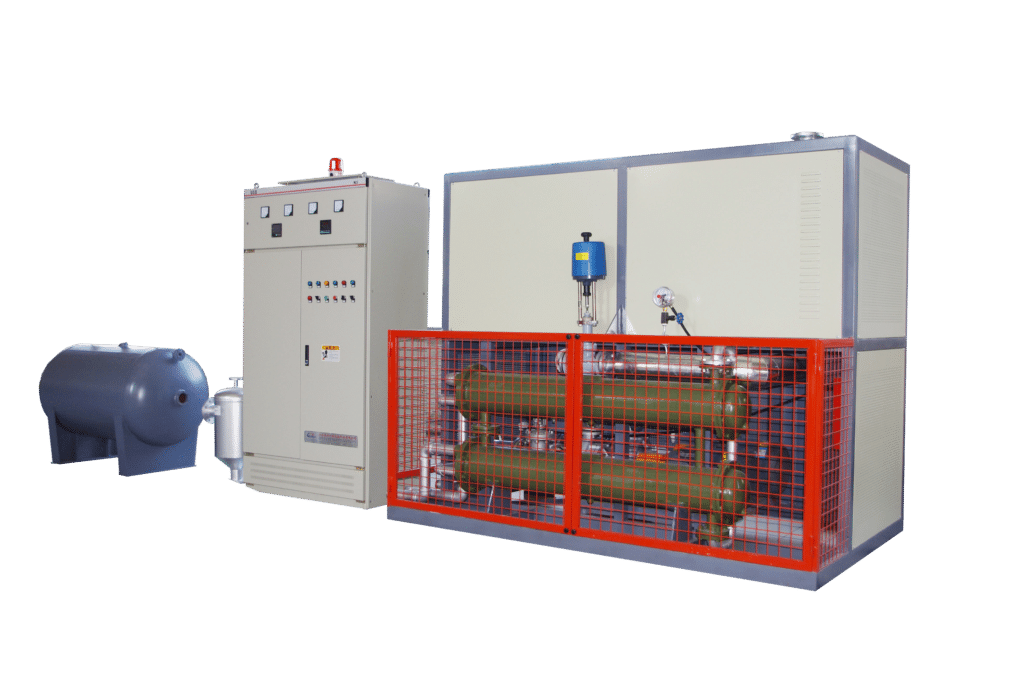Industrial electric heating thermal oil systemshttps://8ruiyan.com/en/all-organic-heat-carrier-boilers/ rely on a critical protector: the Low-Level Tank (LOT). Often overlooked, it sits at the system’s lowest point and is vital for safety.

I. Core Functions: Safety First
- Emergency Relief: Its primary role. Safety valves release hot oil during over-temperature or over-pressure events. The LOT safely contains this oil, preventing fires, explosions, or injuries.
- System Drainage: Stores all oil drained during maintenance, repair, or oil changes.
- Venting & Purging Buffer: Holds small amounts of oil released during system venting or purging.
- Mandatory Requirement: The LOT is a mandatory safety-critical component. Relevant safety codes (e.g., China’s TSG specifications, ASME Boiler & Pressure Vessel Code) require its installation to ensure safe emergency discharge and system shutdown. It is the designated and reliable vessel for safe system venting.
II. Key Design Features
- Lowest Point Location: Installed at the system’s absolute lowest spot (ground level or pit). Must be away from heat sources. Ensures gravity flow into the tank.
- Atmospheric Operation: Works at ambient pressure. Vents to atmosphere via a breather valve (often with flame protection). Prevents pressure buildup.
- Adequate Capacity: Must hold ALL system oil PLUS safety valve maximum discharge volume. Critical for safety.
- Essential Features:
- Insulation: Prevents surface burns.
- Key Components: Level gauge, temperature gauge, pressure gauge, breather valve, manhole, drain valve.
- Nitrogen Blanketing (Recommended): Prevents oil oxidation during storage.
III. Low-Level Tank vs. High-Level Expansion Tank: Know the Difference
| Feature | Low-Level Tank (LOT) | High-Level Expansion Tank (HEP) |
|---|---|---|
| Main Job | Stores emergency & drain oil | Holds expanding oil, adds make-up oil, vents air |
| Role | Safety & emergency vessel | System operation buffer |
| Location | System’s LOWEST point | System’s HIGHEST point |
| Pressure | Atmospheric | Holds system pressure (often with N2 seal) |
| Normal State | Often empty | Always partially filled |
| In Oil Loop? | No | Indirectly yes |
| Mandatory? | YES, Safety Essential | YES, System Operation Essential |
IV. Key Safety Practices
- Comply with Standards: Design, fabrication, and installation must meet pressure vessel codes (e.g., ASME, TSG 21). The LOT is a regulatory requirement.
- Correct Placement: Must be the true lowest point. Discharge pipes: short, straight, steep slope. Keep away from heat.
- Verify Capacity: Re-check size after system modifications.
- Regular Maintenance:
- Ensure breather valve functions.
- Check instrument accuracy (level, temp).
- Maintain insulation.
- Drain sludge regularly (if oil stored).
- Maintain stable N2 pressure (if used).
- Oil Quality Control: Rigorously test stored oil before reuse. Key tests: viscosity, acidity, flash point. Nitrogen preserves oil quality.
- Train Staff: Ensure operators understand the LOT’s purpose and its critical necessity. They must know emergency procedures and maintenance.
Conclusion:
The Low-Level Tank is the silent safety hero. It doesn’t heat your process, but it protects your system. Its low position, simple design, and sufficient size are vital. Critically, it is a mandatory safety requirement per design codes – NOT an optional component. Understand its role. Install it correctly. Maintain it well. This is fundamental to thermal oil system safety.
Remember: For thermal oil safety, the Low-Level Tank is non-negotiable and mandatory.
For further consultation, please contact our technical team for expert advice.
Whatsapp:86-19106101570
wechat:86-19106101570
email:nieyili@cnryan.com
